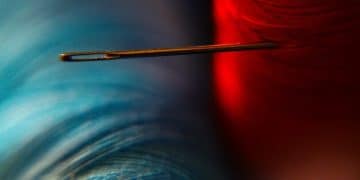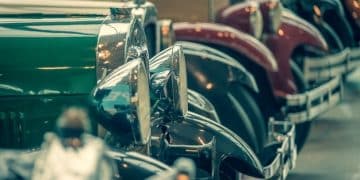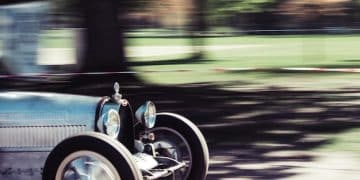The Art of Automotive Photography: Capturing Cars’ Beauty

The art of automotive photography involves skillfully capturing the aesthetic appeal and dynamic essence of vehicles through composition, lighting, and creative techniques, turning cars into compelling subjects.
Automotive photography is more than just pointing and shooting; it’s an art form that requires a keen eye, technical skill, and a passion for cars. Dive into the art of automotive photography and discover how to capture the beauty and essence of these mechanical marvels.
Understanding the Basics of Automotive Photography
Before diving into the creative aspects, it’s essential to understand the fundamental principles of photography. Mastering these basics will provide a solid foundation for capturing stunning automotive images.
From understanding aperture and shutter speed to mastering composition, laying a strong foundation is key to producing amazing car shots.
Mastering Aperture and Shutter Speed
Aperture and shutter speed are two critical settings that control the amount of light entering the camera and the duration of exposure.
The Importance of Composition
Composition refers to the arrangement of elements within the frame. A well-composed image leads the viewer’s eye and creates a visually appealing result.
- Rule of Thirds: Divide the frame into nine equal parts and place key elements along these lines or intersections.
- Leading Lines: Use lines to draw the viewer’s eye towards the subject.
- Symmetry and Patterns: Look for symmetrical arrangements and repeating patterns.
By understanding and applying these basic principles, photographers can elevate their images and capture stunning automotive photography.

Essential Equipment for Automotive Photography
Having the right gear can significantly enhance your automotive photography. While a basic setup can get you started, investing in specific equipment will provide more creative control and better image quality.
While the photographer’s eye is most important, having the proper tools can help give a professional look to your photos.
Cameras and Lenses
Choosing the right camera and lenses can make a significant impact on the quality of your automotive photography.
Tripods and Stabilizers
Tripods and stabilizers are essential for capturing sharp images, especially in low-light conditions or when using longer shutter speeds.
- Tripods: Provide stability for capturing static shots.
- Gimbals: Offer smooth movement for tracking shots.
- Monopods: Offer more maneuverability than tripods, while still providing some stability.
Investing in the right equipment can significantly improve your automotive photography, allowing you to capture sharper images with greater creative control, especially in challenging shooting conditions.
Finding the Perfect Location and Time
The location and time of day play crucial roles in automotive photography. The right setting can complement the car’s design and enhance the overall mood of the image. Understanding how light interacts with your subject at different times of day is equally important.
Location and time of day are two critical elements. A unique location combined with perfect lighting can really make a car pop in a photo.
Scouting Locations
Before heading out for a shoot, scouting potential locations can save time and ensure you find the perfect backdrop.
Golden Hour and Blue Hour
The golden hour (the hour after sunrise and the hour before sunset) and the blue hour (the hour after sunset and the hour before sunrise) are highly valued for their soft, warm light.
- Golden Hour: Warm, soft light that enhances the colors of the car.
- Blue Hour: Cool, subtle light that highlights details without harsh shadows.
- Overcast Days: Offer even lighting, reducing harsh shadows and reflections, perfect for detail shots and capturing accurate colors.
By choosing the right location and understanding the impact of different times of day, you can capture automotive photos that are visually striking and emotionally resonant.
Mastering Lighting Techniques
Lighting is perhaps the most critical element in photography. Understanding how light interacts with the car’s surface and how to manipulate it can transform an ordinary shot into a stunning masterpiece.
Lighting greatly affects the look of car photography. There are many techniques to implement to make your ride glow.
Natural Light vs. Artificial Light
Understanding the differences between natural and artificial light is essential for automotive photography.
Using Reflectors and Diffusers
Reflectors and diffusers are essential tools for shaping and controlling light in automotive photography.
- Reflectors: Bounce light onto the car, filling in shadows and adding highlights.
- Diffusers: Soften direct sunlight, reducing harsh shadows and creating a more even light.
- Fill Flash: Use a speedlight or strobe to add a burst of light, illuminating shadows and balancing the exposure.
Mastering lighting techniques can elevate your automotive photography, allowing you to create images with the perfect balance of light and shadow.

Post-Processing and Editing Tips
Post-processing is a critical step in automotive photography, allowing you to refine and perfect your images. From basic adjustments to more advanced techniques, editing can enhance the colors, contrast, and overall appeal of your photos.
Editing is key to giving your images the perfect final touches. Some minor corrections can add a great deal to the photo’s flair.
Software Options
Various software options are available for post-processing, each with its own set of features and capabilities.
Basic Adjustments
Start with basic adjustments to improve the overall quality of your image and create the desired look.
- White Balance: Correct the color temperature to ensure accurate colors.
- Exposure: Adjust the overall brightness of the image.
- Contrast: Enhance the separation between light and dark tones.
With post-processing, photographers can enhance their automotive images, refining the colors, contrast, and details to create visually striking and compelling results.
Creative Techniques and Special Effects
Beyond the fundamentals, exploring creative techniques and special effects can add a unique touch to your automotive photography. These methods can help you capture dynamic motion, create artistic compositions, and convey a distinct style.
Taking advantage of some fancy techniques can make your images stand out in a gallery of pictures.
Motion Blur and Panning
Motion blur and panning are techniques used to capture the sensation of speed and movement.
Light Painting
Light painting involves using a light source to “paint” light onto the car during a long exposure.
- Long Exposure Settings: Use a long exposure time to capture the light trails.
- Moving Light Source: Move the light source around the car to highlight different areas.
- Creative Effects: Experiment with different colors and patterns of light.
Incorporating creative techniques and special effects can elevate your automotive photography, allowing you to create captivating images that stand out and showcase your unique artistic vision.
| Key Point | Brief Description |
|---|---|
| 📸 Basics of Photography | Master aperture, shutter speed, and composition. |
| 🛠️ Essential Equipment | Invest in cameras, lenses, tripods, and stabilizers. |
| 📍 Perfect Location | Scout locations and use golden/blue hour. |
| 💡 Lighting Techniques | Master natural and artificial light, reflectors, diffusers. |
FAQ
▼
The golden hour and blue hour are often considered the best times due to the soft, diffused light. Overcast days also provide even lighting.
▼
A DSLR or mirrorless camera with interchangeable lenses, a tripod, and basic editing software is a solid starting point.
▼
Use techniques like motion blur, panning, or creative angles. Also, consider the location and background to add energy.
▼
Adjusting white balance, exposure, contrast, and sharpness are critical. Also, you can use color grading to enhance the mood.
▼
Location is vital. It sets the scene and complements the car’s design. Scout for spots that enhance the overall aesthetic of your images.
Conclusion
Mastering the art of automotive photography requires a combination of technical skill, creative vision, and passion for cars. By understanding the fundamentals, investing in the right gear, and honing your post-processing skills, you can capture stunning images that showcase the beauty and essence of automobiles.





